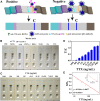Sensitive and rapid detection of tetrodotoxin based on gold nanoflower-and latex microsphere-labeled monoclonal antibodies
- PMID: 37260827
- PMCID: PMC10227513
- DOI: 10.3389/fbioe.2023.1196043
Sensitive and rapid detection of tetrodotoxin based on gold nanoflower-and latex microsphere-labeled monoclonal antibodies
Abstract
Tetrodotoxin (TTX) could result in serious diseases due to its extremely high neurotoxicity. Thus, it is of great importance to measure TTX for food safety. In this study, an anti-TTX monoclonal antibody with good specificity and high affinity was used to develop the immunochromatographic test strips (ICTS). Gold nanoflower (AuNF) with multiple branches and latex microsphere (LM) with large particle size as signal reporters were employed for improving the sensitivity of test strips. Both AuNF and LM probes are stable, and the developed ICTS were specific to TTX, demonstrating no cross-reactivity with other marine toxins. The linear range of AuNF- and LM-based strips for TTX was 9.49-330.98 ng/mL and 5.40-443.19 ng/mL, respectively. The limit of detection (LOD) of AuNF- and LM-based strips was determined to be 9.49 ng/mL and 5.40 ng/mL, respectively. In summary, the developed ICTS based on AuNF and LM signal probes displayed enhancement of sensitivity and provided rapid and specific detection of TTX.
Keywords: detection; gold nanoflower; immunochromatography strip; latex microsphere; monoclonal antibody; tetrodotoxin.
Copyright © 2023 Huang, Xu, Xu, Wu, Sun, Madushika, Wang, Yuan, Wang and Ling.
Conflict of interest statement
The authors declare that the research was conducted in the absence of any commercial or financial relationships that could be construed as a potential conflict of interest.
Figures






Similar articles
-
Establishment of highly sensitive lateral flow immunochromatographic strips for quinclorac detection utilizing signal amplification nanoparticles.Food Chem. 2025 Jan 15;463(Pt 1):140960. doi: 10.1016/j.foodchem.2024.140960. Epub 2024 Aug 22. Food Chem. 2025. PMID: 39236383
-
Development of sensitive and portable immunosensors based on signal amplification probes for monitoring the mercury(II) ions.Biosens Bioelectron. 2022 Dec 1;217:114676. doi: 10.1016/j.bios.2022.114676. Epub 2022 Sep 6. Biosens Bioelectron. 2022. PMID: 36126556
-
Detection of aflatoxin B₁ with immunochromatographic test strips: Enhanced signal sensitivity using gold nanoflowers.Talanta. 2015 Sep 1;142:206-12. doi: 10.1016/j.talanta.2015.04.048. Epub 2015 Apr 25. Talanta. 2015. PMID: 26003713
-
Pt@AuNF nanozyme and horseradish peroxidase-based lateral flow immunoassay dual enzymes signal amplification strategy for sensitive detection of zearalenone.Int J Biol Macromol. 2024 Jan;254(Pt 2):127746. doi: 10.1016/j.ijbiomac.2023.127746. Epub 2023 Nov 3. Int J Biol Macromol. 2024. PMID: 37923041
-
Colloidal Au sphere and nanoflower-based immunochromatographic strips for sensitive detection of zearalenone in cereals.Anal Methods. 2022 Oct 13;14(39):3831-3839. doi: 10.1039/d2ay01365g. Anal Methods. 2022. PMID: 36168770
Cited by
-
Recent research progress in tetrodotoxin detection and quantitative analysis methods.Front Chem. 2024 Aug 14;12:1447312. doi: 10.3389/fchem.2024.1447312. eCollection 2024. Front Chem. 2024. PMID: 39206441 Free PMC article. Review.
-
Development of a latex microsphere-based lateral flow immunoassay for the diagnosis of schistosomiasis japonica.PLoS Negl Trop Dis. 2024 Dec 16;18(12):e0012742. doi: 10.1371/journal.pntd.0012742. eCollection 2024 Dec. PLoS Negl Trop Dis. 2024. PMID: 39680611 Free PMC article.
-
Development of sensitive and specific immunochromatographic strips with nanoparticles for rapid detection of flumequine.Food Chem X. 2025 Jul 9;29:102771. doi: 10.1016/j.fochx.2025.102771. eCollection 2025 Jul. Food Chem X. 2025. PMID: 40686905 Free PMC article.
-
Tetrodotoxin and the state-of-the-art progress of its associated analytical methods.Front Microbiol. 2024 Sep 3;15:1413741. doi: 10.3389/fmicb.2024.1413741. eCollection 2024. Front Microbiol. 2024. PMID: 39290516 Free PMC article. Review.
-
Colorimetric sensing for translational applications: from colorants to mechanisms.Chem Soc Rev. 2024 Jul 29;53(15):7681-7741. doi: 10.1039/d4cs00328d. Chem Soc Rev. 2024. PMID: 38835195 Free PMC article. Review.
References
-
- Bane V., Hutchinson S., Sheehan A., Brosnan B., Barnes P., Lehane M., et al. (2016). LC-MS/MS method for the determination of tetrodotoxin (TTX) on a triple quadruple mass spectrometer. Food Addit. Contam. Part A Chem. Anal. Control Expo. Risk Assess. 33 (11), 1728–1740. 10.1080/19440049.2016.1235801 - DOI - PubMed
LinkOut - more resources
Full Text Sources

